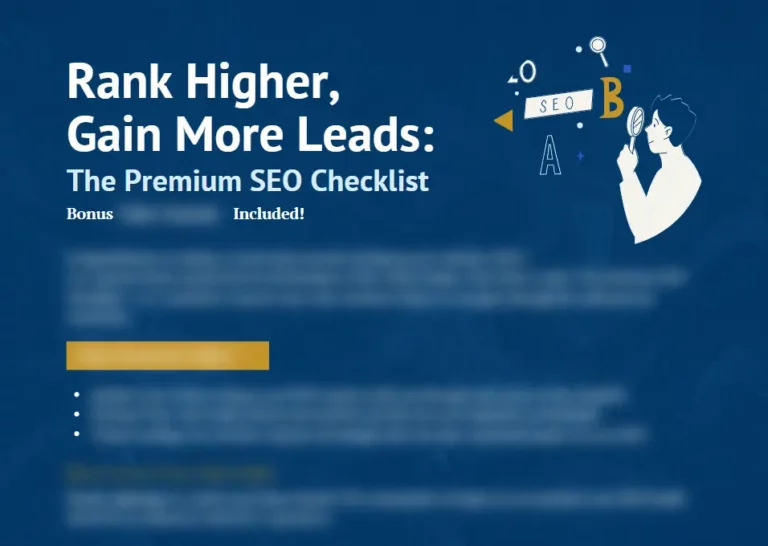In the ever-evolving world of search engine optimization (SEO), one aspect remains constant – the fierce competition for the top spots on search engine results pages (SERPs).
But how do you stay ahead in this race?
Enter competitive SEO analysis.
By analyzing your competitors, you can learn from their strengths and weaknesses, uncover untapped opportunities, and create a winning SEO strategy that propels your website to the top.
Ready to dive in? Let’s get started!
TL:DR
- Competitive SEO analysis involves studying competitors’ strategies to gain an understanding of their strengths and weaknesses.
- Keyword research, analyzing search results, and examining competitor websites are essential for identifying SEO competitors.
- Utilizing insights from competitive analysis can help optimize a website’s success by targeting keywords, creating content, building a strong backlink profile and monitoring keyword performance.
Understanding Competitive SEO
Picture this: you’re a runner, and you want to win the race.
You know you need to train, but you can’t just focus on your own performance.
You need to study your competitors, understand their strengths, and exploit their weaknesses to come out on top.
The same principle applies to SEO.
Competitive SEO analysis takes a deep dive into your competitors’ strategies, allowing you to enhance your own SEO efforts and improve your search rankings.
But first, let’s define what competitive SEO is and explore its benefits.
Defining Competitive SEO
Competitive SEO analysis is the process of analyzing and leveraging your competitors’ strategies to maximize the effectiveness of your own SEO efforts.
It involves identifying your direct business competitors, uncovering the keywords they rank for, and examining their content, backlinks, and technical SEO aspects.
Semrush is an excellent tool that provides a comprehensive set of SEO competitive analysis tools for competitor research.
The key to a successful competitive SEO analysis is to regularly monitor your competitors and adjust your strategy accordingly.
An SEO competitor analysis template can be a valuable asset in this process, helping you create a detailed SEO competitor analysis report.
A crucial aspect of competitive SEO analysis is identifying keyword gaps – the disparity between the keywords your competitors are ranking for and those you are not.
Semrush’s Keyword Gap tool can help you identify these gaps by comparing your URL with up to four competitor URLs.
Recognizing and targeting these keyword gaps allows you to uncover new opportunities and maintain a competitive edge in your niche.
Benefits of Competitive SEO Analysis
Conducting a competitive SEO analysis provides invaluable insights into your competitors’ strengths and weaknesses, revealing potential opportunities and allowing you to stay ahead of the competition.
By assessing your competitors’ SEO performance, you can identify areas for improvement and capitalize on their shortcomings.
For example, using Semrush’s Bulk Analysis tool, you can compare your website’s authority score against your competitors’, helping you understand where you stand in the competitive landscape.
Another advantage of competitive SEO analysis is the ability to uncover new opportunities for growth.
Ahrefs’. Content Gap tool can help you identify content gaps – keywords your competitors rank for but you do not.
By targeting these low/medium difficulty, high-volume opportunities, you can add the most relevant new keywords to your strategy and expand your reach in the market.
With these benefits in mind, let’s dive into the process of identifying your SEO competitors.
Identifying Your SEO Competitors
The first step in competitive SEO analysis is identifying your main competitors.
While it might be tempting to simply focus on the most prominent players in your industry, it’s crucial to zero in on the websites that are truly competing with you in terms of SEO.
This involves conducting keyword research, analyzing search results, and examining competitor websites to gain a comprehensive understanding of your competitive landscape.
Let’s explore these steps in more detail.
Keyword Research for Competitor Identification
To identify your SEO competitors, you need to start with keyword research.
By analyzing the keywords that both you and your competitors are targeting, you can gain valuable insights into their SEO strategies and uncover potential opportunities for your own website.
Begin by compiling a list of informational keywords that prospects typically use during the awareness stage of the customer journey.
This will help you understand which websites are consistently ranking for your target keywords and identify your true SEO competitors.
Analyzing Search Results
Once you have identified your competitors through keyword research, the next step is to analyze search results to determine which competitors consistently rank highly for your target search queries.
This involves examining the websites that appear in the search engine results pages (SERPs) for your target keywords and identifying any patterns or trends that emerge.
By understanding which websites are consistently ranking highly, you can gain valuable insights into the strategies they are employing to achieve success and identify areas where you can improve your own SEO efforts.
To gain a more comprehensive understanding of your competitors’ visibility in search results, you can leverage tools like Alexa’s traffic report, which provides insights into where your competitors are obtaining their traffic and the methods they are using.
By analyzing search results and competitor visibility, you can effectively identify your true SEO competitors and better understand the competitive landscape in which you are operating.
Examining Competitor Websites
With a clear understanding of your SEO competitors, it’s time to take a closer look at their websites. Examining competitor websites can provide valuable insights into their content, backlinks, and technical SEO aspects.
By assessing their content, you can identify popular topics, content gaps, and areas for improvement in your own content strategy.
Analyzing their backlink profiles can help you understand their link-building strategies and identify potential link opportunities.
Furthermore, evaluating the technical SEO aspects of competitor websites can uncover areas for optimization, such as site structure, page speed, and mobile-friendliness.
By examining competitor websites and understanding their strengths and weaknesses, you can make informed decisions about your own SEO strategy and focus on areas that will provide the greatest return on investment.
Performing an In-Depth SEO Competitor Analysis
Now that you have identified your SEO competitors, it’s time to dig deeper and perform an in-depth SEO competitor analysis.
This involves evaluating their content, backlink profiles, and technical SEO aspects to gain valuable insights and identify areas for improvement in your own SEO strategy.
By conducting a thorough competitor analysis, you can learn from your competitors’ strengths and weaknesses and create a winning SEO strategy that propels your website to the top of the search engine results pages.
Let’s explore each of these aspects in more detail.
Content Analysis
Analyzing your competitors’ content is a crucial step in the SEO competitor analysis process.
By examining the topics they cover, the quality of their content, and the frequency with which they publish, you can identify popular topics and content gaps that your own website can address.
This will help you develop a content strategy that caters to your target audience’s needs and interests while differentiating your website from your competitors.
In addition to identifying content gaps, analyzing competitors’ content can also reveal areas where your own content can be improved.
For example, if your competitor consistently ranks highly for a particular keyword, you can examine their content to understand what aspects are driving their success and apply those insights to your own content strategy.
By leveraging the insights gained from content analysis, you can create high-quality, engaging content that outperforms your competitors and attracts more organic search traffic to your website.
Backlink Profile Analysis
Backlinks play a crucial role in SEO, as they act as “votes of confidence” from other websites that signal to search engines that your content is valuable and authoritative.
By analyzing your competitors’ backlink profiles, you can gain insights into their link-building strategies and identify potential link opportunities for your own website.
This can help you build a strong backlink profile that improves your search engine rankings and drives more organic traffic to your site.
When assessing your competitors’ backlinks, it’s important to consider the quality of the linking site, the relevance of the linking page, and the anchor text used.
By identifying high-quality, relevant backlinks that your competitors have acquired, you can target these same sources in your own link-building efforts.
This will help you build a diverse and authoritative backlink profile that propels your website up the search engine rankings.
Technical SEO Analysis
Technical SEO is an often overlooked aspect of SEO competitor analysis, but it plays a critical role in determining your website’s search engine rankings.
By conducting a technical SEO analysis of competitor websites, you can uncover areas for optimization, such as site structure, page speed, and mobile-friendliness.
Addressing these technical SEO gaps can improve your website’s user experience and search engine rankings, giving you a competitive edge.
For example, improving your website’s site structure can make it easier for both users and search engines to navigate and find content.
Ensuring your website loads quickly and is mobile-friendly can also improve user experience and search engine rankings, as search engines prioritize sites that provide a seamless experience for users.
By addressing these technical SEO gaps and learning from your competitors’ approaches, you can optimize your own website for better rankings and greater visibility in search results.
Utilizing Competitive SEO Analysis Insights
With a wealth of insights gained from your competitive SEO analysis, it’s time to put this knowledge to work and optimize your website for success.
By developing a targeted keyword strategy, creating high-quality content, and building a strong backlink profile, you can outperform your competitors and secure a prime spot on the search engine results pages.
Let’s delve deeper into how you can utilize these insights to create a winning SEO strategy.
Developing a Targeted Keyword Strategy
A targeted keyword strategy is the backbone of any successful SEO campaign.
By analyzing your competitors’ keyword strategies, you can identify high-ROI keywords and untapped niches to target with your own keyword strategy.
This will help you focus your SEO efforts on the most valuable keywords and ensure that your website ranks highly in search engine results pages.
To develop a targeted keyword strategy, start by researching and analyzing relevant keywords and understanding the search intent behind them.
Next, produce content that is optimized for these keywords, ensuring that it addresses user intent and provides value to your target audience.
Finally, monitor your keyword performance and adjust your strategy as needed to ensure that your website remains competitive in the ever-changing world of SEO.
Creating High-Quality Content
Content is king in the world of SEO, and creating high-quality, engaging content is essential for outranking your competitors and attracting organic search traffic to your website.
By analysing your competitors’ content, you can identify popular topics and content gaps that your own website can address.
This will help you develop a content strategy that caters to your target audience’s needs and interests while differentiating your website from your competitors.
In addition to addressing content gaps, you should also focus on creating content that provides unique value to users.
This means crafting well-written, authoritative content that demonstrates your expertise and provides helpful information to your target audience.
By creating high-quality content that outperforms your competitors, you can improve your SEO rankings and drive more organic traffic to your website.
Building a Strong Backlink Profile
As mentioned earlier, backlinks play a crucial role in SEO, as they act as “votes of confidence” from other websites that signal to search engines that your content is valuable and authoritative.
By analyzing your competitors’ backlink profiles, you can gain insights into their link-building strategies and identify potential link opportunities for your own website.
This can help you build a strong backlink profile that improves your search engine rankings and drives more organic traffic to your site.
To build a strong backlink profile, start by targeting high-quality, relevant backlinks from authoritative websites.
This can be done through various methods, such as guest posting, outreach, or content promotion.
Additionally, learning from your competitors’ link-building strategies can help you identify new link opportunities and tactics that you can incorporate into your own strategy.
By building a diverse and authoritative backlink profile, you can improve your search engine rankings and secure a prime spot on the search engine results pages.
Monitoring and Adjusting Your SEO Strategy
Success in SEO is an ongoing process, requiring continuous monitoring and adjustment of your strategy to maintain and improve your search engine rankings.
By tracking keyword performance, keeping an eye on competitors, and adapting to algorithm updates, you can ensure that your SEO strategy remains effective and responsive to the ever-changing search landscape.
Let’s explore these aspects in more detail and discuss how to monitor and adjust your SEO strategy for sustained success.
Tracking Keyword Performance
Tracking keyword performance is essential for measuring the success of your SEO efforts and identifying areas for improvement.
By monitoring your keyword rankings and analyzing changes over time, you can determine which keywords are performing well and which need additional attention.
This data can help you adjust your SEO strategy to ensure that you’re focusing on the most valuable keywords and optimizing your website for the best possible search engine rankings.
To track keyword performance, you can leverage tools like Google Search Console, SEMrush, Ahrefs, and Moz, which provide data and metrics regarding specific keywords, such as search volume, competition, and ranking position.
By continuously monitoring keyword performance, you can stay informed of changes in your search engine rankings and make data-driven decisions about your SEO strategy.
Keeping an Eye on Competitors
Staying ahead in the competitive world of SEO requires not only optimizing your own website, but also keeping a close eye on your competitors.
By continuously monitoring your competitors’ strategies, you can stay informed of their tactics and adjust your own approach accordingly.
This can help you maintain a competitive edge and ensure that your website remains visible and relevant in search engine results pages.
There are several tools available, such as SEMrush and Ahrefs, that can help you monitor your competitors and gain insights into their SEO performance.
These tools provide data on competitors’ keyword rankings, backlink profiles, and technical SEO aspects, allowing you to identify opportunities for improvement in your own strategy.
By staying informed about your competitors’ activities and learning from their successes and failures, you can ensure that your SEO strategy remains effective and responsive to the ever-changing search landscape.
Adapting to Algorithm Updates
Search engine algorithms are constantly evolving, with updates designed to improve the quality of search results and provide a better experience for users.
It’s crucial for your SEO strategy to adapt to these algorithm updates in order to maintain and improve your search rankings.
By staying informed of algorithm changes and adjusting your strategy accordingly, you can ensure that your website remains competitive in the ever-changing world of SEO.
Adapting to algorithm updates may involve tracking keyword performance, monitoring competitors, formulating a targeted keyword strategy, producing high-quality content, and constructing a robust backlink profile.
By staying on top of algorithm updates and adjusting your strategy as needed, you can ensure that your website remains visible and relevant in search engine results pages, driving more organic traffic and achieving sustainable SEO success.
Gain the Upper Hand
Competitive SEO analysis is an essential element of any successful SEO strategy.
By collaborating with an SEO agency, you can save time and resources, allowing you to focus on your core business operations while leaving the complexities of SEO to the experts.
Now it’s time to seize the opportunity and harness the power of competitive SEO analysis to transform your website’s search engine rankings and achieve sustainable SEO success.
Frequently Asked Questions
What is SEO competition?
SEO competition is the online presence of other websites and webpages vying for higher rankings in search engine results alongside your own target page.
Why is competitive analysis important in SEO?
Competitive analysis is an essential part of SEO, as it helps identify what your competitors are doing to rank higher in search engine results and provides insights on how to improve your website’s visibility.
By understanding what your competitors are doing, you can develop a strategy to outrank them and increase your website’s visibility in search engine results.
This can be done by optimizing your website for relevant keywords, improving your website’s content, and building backlinks.
How do you analyze your competitors SEO strategy?
By studying backlink growth, spying on competitors’ organic keywords and featured snippets, analyzing traffic breakdown by country, locating broken pages, finding content gaps, and pinpointing the most popular content of your competitors, you can effectively analyze their SEO strategy.
This can help you identify opportunities to improve your own SEO strategy and gain an edge over your competitors.
What are the benefits of working with an SEO agency for competitive SEO analysis?
Working with an SEO agency can help you maximize the potential of your SEO strategy by providing expert guidance, access to advanced tools and resources, and ongoing support.
By leveraging the expertise of an SEO agency, you can ensure that your SEO strategy is optimized for success.
They can provide you with insights into the latest trends and best practices, as well as help you identify opportunities for improvement.




